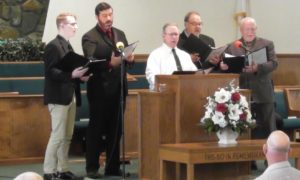
Are there other church pianists besides myself who work with instrumental or vocal groups for special music at your church?
Over the years I’ve developed some guidelines to help us use our time wisely. I know every church has its own level of abilities. That being said, you may need more or less practice than what’s suggested below.
We stick with unison or two part arrangements for our ladies’ and two to three parts for our men’s groups. You would be amazed at how nice unison can sound… especially if the pianist can make up for lack of harmony by using chord substitutions…creating a colorful; rich sound.
I try to allow for a total of six rehearsals when the arrangement is new to them. The group just stands around the piano for all but the last practice. (Details below) In addition, I email practice audios for those wanting additional practice. With the group providing surround sound around the piano…I’m able to listen to their blend, balance of parts, etc. and better coach them as they sing. Once the group becomes familiar with the words…say…maybe after the first three practices…I’ll ask them a question about the approaching sentences in the song (while they’re singing and I’m playing)… forcing them to think about what they are singing. I LOVE doing this, because you can hear the difference in their voice expression…making for very effective communication!
For example, I’ll use the hymn “Amazing Grace” since everyone knows it 🙂 While the group is singing the first sentence..”Amazing grace how sweet the sound…”
I’ll ask the following question for the upcoming sentence…”What did God’s grace do for you?!” They’ll answer in singing response “That saved a wretch like me!” 🙂 The results: A more meaningful delivery!
If it’s an arrangement they have done before…we may only have four practice sessions.
Our practice sessions are generally no more than 10 minutes.
General checklist for carrying out the group rehearsals:
- Beginning of 1st practice (may need to cover at second practice too in case someone was missing at first practice), hand out practice schedule which includes the date and service for when they are singing.
- Kindly tell the group that it will work best to attend all of the scheduled practices in order to be adequately prepared. Otherwise…they can wait until the next scheduled time. (Exception: missing one practice due to sickness or other unavoidable reason).
- Make following suggestion: Arrange someone to watch your young kid(s) during these practices. (Our ladies are SO good about doing this)
- Please remind them that each person is essential to the group as a whole. (Have them stand in the same order for each practice.) Each person gets accustomed to singing by the same person for each practice so it can throw a person off when they’re missing a team member.
- The vocal ensemble will practice on stage around the pulpit during the final rehearsal for a sound check. (Arrange for sound person to be at this rehearsal so he or she can do the sound check.)
- Our ultimate goal is to honor Christ by being adequately prepared. I Corinthians 14:40 “Let all things be done decently and in order.”*I usually have groups practice around the piano that I’m playing for a more up-close
Most of the above suggested guidelines will also apply to instrumental ensembles….depending on the age of your members.
Hopefully the information above has been an encouragement to other church pianists who work with vocal and/or instrumental ensembles.
*Next article: What details I work on with ensembles during these brief rehearsals







